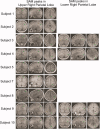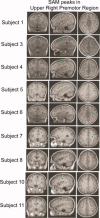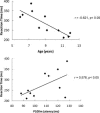White matter maturation in visual and motor areas predicts the latency of visual activation in children
- PMID: 21432944
- PMCID: PMC6870090
- DOI: 10.1002/hbm.21203
White matter maturation in visual and motor areas predicts the latency of visual activation in children
Abstract
In humans, white matter maturation is important for the improvement of cognitive function and performance with age. Across studies the variables of white matter maturity and age are highly correlated; however, the unique contributions of white matter to information processing speed remain relatively unknown. We investigated the relations between the speed of the visually-evoked P100m response and the biophysical properties of white matter in 11 healthy children performing a simple, visually-cued finger movement. We found that: (1) the latency of the early, visually-evoked response was related to the integrity of white matter in both visual and motor association areas and (2) white matter maturation in these areas accounted for the variations in visual processing speed, independent of age. Our study is a novel investigation of spatial-temporal dynamics in the developing brain and provides evidence that white matter maturation accounts for age-related decreases in the speed of visual response. Developmental models of cortical specialization should incorporate the unique role of white matter maturation in mediating changes in performance during tasks involving visual processing.
Copyright © 2011 Wiley Periodicals, Inc.
Figures







Similar articles
-
A non-invasive method to relate the timing of neural activity to white matter microstructural integrity.Neuroimage. 2008 Aug 15;42(2):710-6. doi: 10.1016/j.neuroimage.2008.04.264. Epub 2008 May 13. Neuroimage. 2008. PMID: 18565766 Free PMC article.
-
Development of the visual white matter pathways mediates development of electrophysiological responses in visual cortex.Hum Brain Mapp. 2021 Dec 1;42(17):5785-5797. doi: 10.1002/hbm.25654. Epub 2021 Sep 6. Hum Brain Mapp. 2021. PMID: 34487405 Free PMC article.
-
Relations between white matter maturation and reaction time in childhood.J Int Neuropsychol Soc. 2014 Jan;20(1):99-112. doi: 10.1017/S1355617713001148. Epub 2013 Oct 29. J Int Neuropsychol Soc. 2014. PMID: 24168858
-
White matter plasticity and maturation in human cognition.Glia. 2019 Nov;67(11):2020-2037. doi: 10.1002/glia.23661. Epub 2019 Jun 24. Glia. 2019. PMID: 31233643 Review.
-
Maturation of white matter in the human brain: a review of magnetic resonance studies.Brain Res Bull. 2001 Feb;54(3):255-66. doi: 10.1016/s0361-9230(00)00434-2. Brain Res Bull. 2001. PMID: 11287130 Review.
Cited by
-
Tumor region associated with specific processing speed outcomes.Pediatr Blood Cancer. 2023 Mar;70(3):e30167. doi: 10.1002/pbc.30167. Epub 2023 Jan 10. Pediatr Blood Cancer. 2023. PMID: 36625401 Free PMC article.
-
Functional and structural maturation of auditory cortex from 2 months to 2 years old.Clin Neurophysiol. 2024 Oct;166:232-243. doi: 10.1016/j.clinph.2024.08.007. Epub 2024 Aug 15. Clin Neurophysiol. 2024. PMID: 39213880
-
Eyeing up the Future of the Pupillary Light Reflex in Neurodiagnostics.Diagnostics (Basel). 2018 Mar 13;8(1):19. doi: 10.3390/diagnostics8010019. Diagnostics (Basel). 2018. PMID: 29534018 Free PMC article. Review.
-
Children show hemispheric differences in the basic auditory response properties.Hum Brain Mapp. 2019 Jun 15;40(9):2699-2710. doi: 10.1002/hbm.24553. Epub 2019 Feb 18. Hum Brain Mapp. 2019. PMID: 30779260 Free PMC article.
-
Changes in White Matter Microstructure Impact Cognition by Disrupting the Ability of Neural Assemblies to Synchronize.J Neurosci. 2017 Aug 23;37(34):8227-8238. doi: 10.1523/JNEUROSCI.0560-17.2017. Epub 2017 Jul 25. J Neurosci. 2017. PMID: 28743724 Free PMC article.
References
-
- Allison T, Wood CC, Goff WR ( 1983): Brain stem auditory, pattern‐reversal visual, and short‐latency somatosensory evoked potentials: Latencies in relation to age, sex, and brain and body size. Electroencephalogr Clin Neurophysiol 55: 619–636. - PubMed
-
- Als H, Duffy FH, McAnulty GB, Rivkin MJ, Vajapeyam S, Mulkern RV, Warfield SK, Huppi PS, Butler SC, Conneman N, Fischer C, Eichenwald EC ( 2004): Early experience alters brain function and structure. Pediatrics 113: 846–857. - PubMed
-
- Barnea‐Goraly N, Menon V, Eckert M, Tamm L, Bammer R, Karchemskiy A, Dant CC, Reiss AL ( 2005): White matter development during childhood and adolescence: A cross‐sectional diffusion tensor imaging study. Cereb Cortex 15: 1848–1854. - PubMed
-
- Barnikol UB, Amunts K, Dammers J, Mohlberg H, Fieseler T, Malikovic A, Zilles K, Niedeggen M, Tass PA ( 2006): Pattern reversal visual evoked responses of V1/V2 and V5/MT as revealed by MEG combined with probabilistic cytoarchitectonic maps. Neuroimage 31: 86–108. - PubMed
Publication types
MeSH terms
Grants and funding
LinkOut - more resources
Full Text Sources

